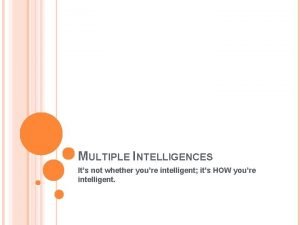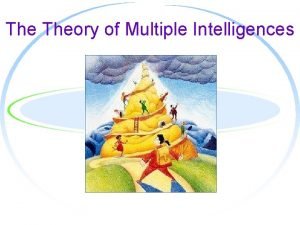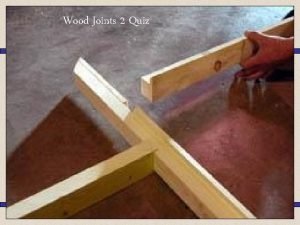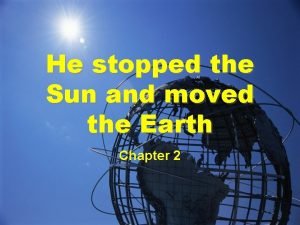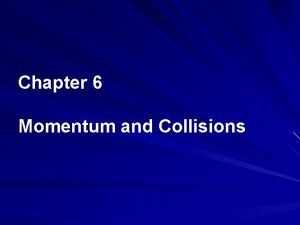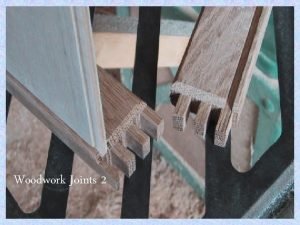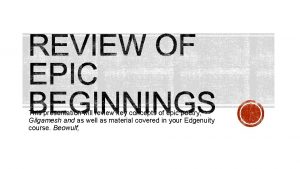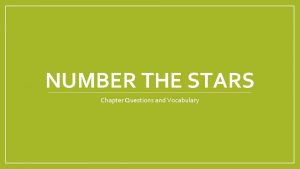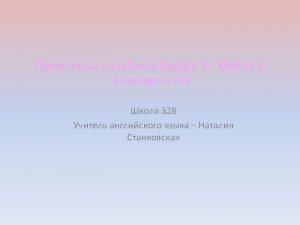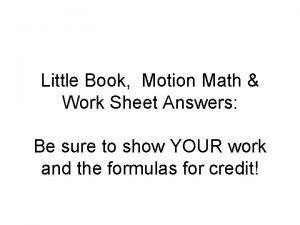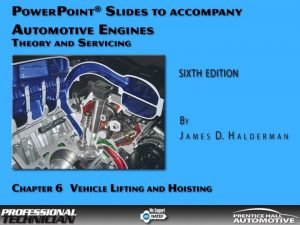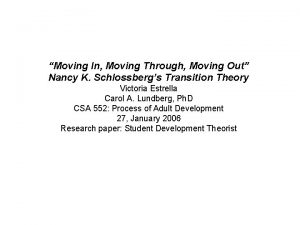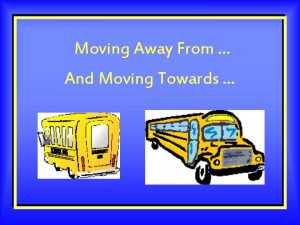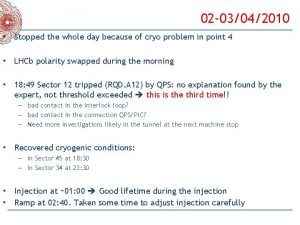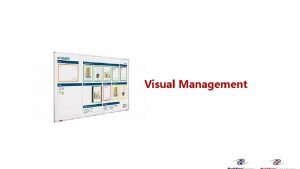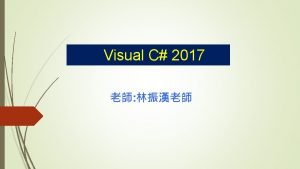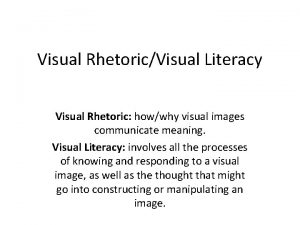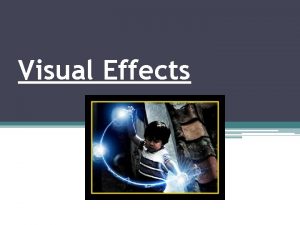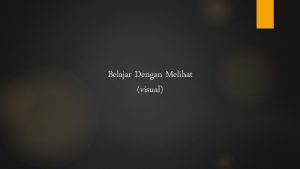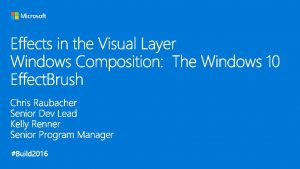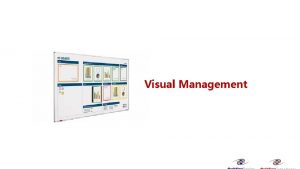The Day the World Stopped Visual Intelligence Moving






























- Slides: 30

The Day the World Stopped Visual Intelligence Moving Chapter 6

An Unusual Complaint A KI NE A I PS TO The permanent loss of movement vision in all 3 Dimensions Trans cr anial M agneti c Stim • Made it possible to experience brief motion loss without causing brain damage • impairs normal electric functions in V 5 with aid of magnetic fields ula

How do we recognize objects without seeing them move? Motion, like color, is constructed by our own visual intelligence. The link between what is moving and how it is moving? Exner's Phi Motion offers some insight.

Two flashing dots may appear to be moving depending on their interstimulus interval (time and space) Demonstrates motion and objects are created interdependently Our construction of motion depends on whether


Wertheimer's Color Phi Motion Used two different dot colors You should see second color appear in space between two dots. You not only construct the space and motions that you see, you also construct the time sequence of what you see.


y r e v o isc D s ' e ink L. E. P • Discovered that you can construct motion over a curved path Vittori o Benus si • Even without a drawn curve, you can still construct this motion Rule 29. Create the simplest possible motions.

Josef Ternus' Display with Flashing Dot Pairs Depending on the ISI, you could see: Group Motion • Two dots moving together from left to right Element Motion • Long range motion of outside dot

Multilayered Construction Gro n o i t o up M Ele me nt M otio n

Paul von Schiller's Input You can construct more than one type of motion. But, only one is seen at a time for the sake of conserving number of objects. Rule 30. When making motion, construct as few objects as possible, and conserve them as much

Rule 30. When making motion, construct as few objects as possible, and conserve them as much as possible.

Rule 31. Construct motion to be as uniform over space as possible.

Max Wertheimer and his Rotating Windmill Clockwise or

1986 - Antsis and Ramachandran Display ? e s i ckw Clo Coun terclo ckwis You prefer to rotate the shortest distance, while also investing your motions with inertia. e?

Our Rotation Prowess 1937 - Brown and Roth Long ISI's - straight line motions Short ISI's - a continuous motion circle

Barber Poles • Presents us with the "aperture problem" as stripes move upward while turning on horizontal axis • the smoothest velocity field (path of motion) has the stripes moving straight up • The smoothest path - velocity of motion changes the least • constructed motion at one points depends on the motion at other points • smoothness requires a

Rule 32. Construct the smoothest Velocity Field • “Velocity Field” – the path of motion • The smoothest path velocity of the motion changes the least. Aperture Problem • The motion you construct at one point depends on the motion you construct at nearby points. • Smoothness is a relation between motions at different points.

Ted Adelson and Tony Movshon Do you see the grates sliding past each other or one coherently moving object?

Difference in Two Grates Your creation of motions and objects is intelligently coordinated by size, contrast, depth and color. The greater the difference (size, contrast, color, or depth) between the two grates

Rigid Motion Points in space will move rigidly if all distances between point positioning remain constant during the motion.

As the dots move their positions slightly will from frame to frame, a 3 dimensional form will be constructed. Rule 33. If possible, and if other rules permit, interpret image motions as projections of

Ullman's Rigidity Theorem “Suppose you are given three frames, each containing at least four points. If the points are placed at random in each frame, then the probability is zero that they have a rigid interpretation in three dimensions. If the points do have a rigid interpretation, then they almost surely have exactly two interpretations (which are mirrorsymmetric). ” All you need is as little as 3 frames each having 4 points to create a 3 D object and its motion.

Limits of Ullman's Theory Predicting the movement of the human body is not easy.

The Power of Dots Placing dots on the joints of actors While all joints do not move rigidly, thus going against rigidity principle, the 3 dimensional object can still be created

Rule 34. If possible, and if other rules permit, interpret image motions as projections of 3 dimensional motions that are rigid and planar. Because of the biological make up of our joints, our bones swing on planes. Rigidity and Planarity will usually work with other rules too such as rules about smoothness or dynamical constraints.

Dan Kersten's Conclustion Visually, we're clever! - We interpret a smooth diagonal movement along the checkerboard as the shadow moves. http: //gandalf. psych. umn. edu/users/kersten/kerst en-lab/images/ball-in-a-box. mov However, we still make mistakes. - We allow the shadow and ball to contradict - we create unusual movements based on the light source

Rule 35. Light sources move slowly. Motion in 3 D depends not only on the object, but also on how you interpret the relation between it and its shadow.

COLOR! Tom Albright and Karen Dobkins claim that there is a strong interaction between the magnocellular (motion, luminance, depth, and coarse form) and parvocellular (color, fine form). We prefer that objects of the same color

Hoffman's Dynamic Color Spreading Creating motion through color with stationary dots
 Day 1 day 2 day 3 day 4
Day 1 day 2 day 3 day 4 Day 1 day 2 day 817
Day 1 day 2 day 817 Alan jackson where were you when the world stopped turning
Alan jackson where were you when the world stopped turning Naturalist intelligence definition
Naturalist intelligence definition Intrapersonal famous person
Intrapersonal famous person Visual or spatial intelligence
Visual or spatial intelligence Celebrities with kinesthetic intelligence
Celebrities with kinesthetic intelligence What is the interpersonal intelligence
What is the interpersonal intelligence Stopped housing joint
Stopped housing joint Stopped the sun and moved the earth
Stopped the sun and moved the earth Type of momentum
Type of momentum Aborted duel with antonio luna
Aborted duel with antonio luna Flat pack joints
Flat pack joints At four hundred miles they stopped to eat
At four hundred miles they stopped to eat Why isn’t kirsti afraid of the soldiers?
Why isn’t kirsti afraid of the soldiers? Stop working phrasal verb
Stop working phrasal verb Sol
Sol The car stopped graph
The car stopped graph Stopped flow
Stopped flow Sae standard for hoist location
Sae standard for hoist location Fiona stopped smoking last year
Fiona stopped smoking last year Yang termasuk bahasa pemrograman konvensional adalah
Yang termasuk bahasa pemrograman konvensional adalah William beanes elementary
William beanes elementary Oceans apart day after
Oceans apart day after Day to day maintenance
Day to day maintenance Physical science chapter 6 review answers
Physical science chapter 6 review answers I don't know about tomorrow
I don't know about tomorrow Romeo and juliet act 1 timeline
Romeo and juliet act 1 timeline Growing day by day
Growing day by day Define seed dormancy
Define seed dormancy Seed germination conclusion
Seed germination conclusion




